The Icelandic Breed
About Icelandic Sheep
Icelandic sheep were first introduced into Iceland by the Vikings sometime between 800 and 900 A.D. Since that time, they have changed little, being of medium size, and with rams and ewes either horned or polled. The fleece range from white to the natural colors of brown (moorit) and black, in five color patterns that can occur singly or together, and with the possible presence of spots – nearly 30 possibilities in all. The sheep are double-coated, with a long, coarse outer coat (tog) and very fine undercoat (thel). The two fiber types may be spun together (known as Lopi), or may be separated and spun individually. Tog yarn is suitable for applications requiring strength and wearability, such as in rugs; the thel yarn is suitable even for baby garments.
Until after WWII, sheep flourished exclusively on pasture year-round in Iceland. Because of the need for sheep to travel safely to winter pasture in inclement weather, certain sheep that were observed to possess an unusual ability to sense direction and detect danger were selected and bred. These highly intelligent “leadersheep” are rather uncommon now as they are no longer needed for their original purpose, but their qualities are greatly appreciated, and there are leadersheep in many flocks.
North American Icelandic sheep date back to importations into Canada in the 1980’s by Stefania Digum (Yeoman Farm), and later into the United States by Barbara Webb of Jager Farm. While still relatively scarce in North America, Icelandics continue to grow in popularity for their fleece, meat, and milk. Our sheep come in a wide range of colors and patterns, and we are breeding for this diversity and for soft fleece, gentle personality, and milk. We also are breeding specifically for leadersheep lines.
Since all of the sheep are halter-trained, they are easy to manage during routine health procedures and when they need to be moved from one location to another. We maintain a flock of ewes, rams, and wethers. Please enjoy the pictures of some of our sheep, and check back frequently to see what we have for sale.
Leadersheep
The Icelandic leader sheep is a separate line within the Icelandic breed of sheep (27). The Leader sheep were probably brought to Iceland together with other sheep at the time of settlement in the 8th and 9th century. The sheep are lightly built with long legs and not as heavy as the Icelandic sheep, but otherwise similar. The leader sheep are known for their leader characteristics and a specific sense of directions, that were highly valued traits under the extensive farming conditions in Iceland in earlier times. The leader sheep were used to bring the flock home in bad weather during winter grazing and they are still used to lead the flock when sheep are moved to and from summer pastures. The leader sheep are now a small population of around 1,000 purebred adult sheep that are spread between many flocks, with a few leader sheep on each farm. Leader rams have been kept at the AI stations in Iceland since 1981 as an aid to the conservation of the leader sheep.
-http://www.rala.is/
ISBONA REgistration
We are members of CLRC (TRINITY, #5347167), ISBONA (flock code BEL), and the Icelandic Leadersheep Society.
.







